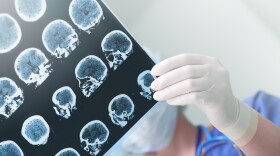When they can’t get opioid painkillers, a growing number of addicts turn to anti-diarrhea medication like Imodium for a cheap high, but with serious consequences. Some call it "the poor man's methadone."
Highlights from the conversation with Dr. Shannon Rickner, a toxicologist with the North Texas Poison Center at Parkland Hospital:
How Imodium (and other anti-diarrheal medications) works as a substitute for painkillers: “It actually works on the same receptors as the other opioid medications work on. (The active ingredient is) loperamide. It binds to the same receptors that heroin or morphine, hydrocodone – all of those medications and drugs bind to that receptor, too. And these receptors are everywhere. They’re inside the lining of your G-I (gastrointestinal) system. They’re also up your brain. Now when they’re in the brain, those are the receptors that, when they’re bound, give you that sensation of being high. They give you all the things you would see with someone who was using and addicted to heroin other prescription opioids. What happened was when we had the epidemic of people who were becoming addicted to either heroin or prescription opioid medications, they tried to detox themselves and quit. And they would wind up with unbelievably horrible withdrawal-type symptoms. So they started using Imodium, knowing that it worked on those receptors to try and help them cope with those withdrawal symptoms. So, how that branched into the thought of “Oh, well maybe if it worked on the same receptors, if I take enough of it, maybe it will actually cross the G-I barrier, get into the bloodstream, get up to my brain, and give me the high that heroin might without having to pay or access prescription opioids or heroin itself.”
Who is using anti-diarrheal medication in this way: “It’s becoming more and more difficult to get access to prescription pain medication, and there still is quite a stigma about illicit narcotic drugs. Someone will look at it and say 'Well it’s a prescription medication or it’s an over-the-counter medication, it’s manufactured by a pharmaceutical company, therefore it’s much, much safe than that which I could get off of the street.' Or they don’t have access in the first place. And a lot of it is just young twenty-somethings who are just trying to find new and different clever ways that won’t necessarily show up on toxicology panels or other drug screens.”
How much you have to consume to get high: “We have case studies of 20, 30, 40 tablets at a time being taken. And then of the entire system is overwhelmed, so it crosses the G-I barrier, gets up into the brain, and there’s still a lot of debate as to whether this is actually is really an actual legitimate high or whether people are experiencing a placebo effect. So it’s unclear how much of it gets into the brain, into the central nervous system, to give you a high. What we do know is that this medication also has some potential consequences, especially in very, very large doses. That it can actually start to affect the electrical activity and conduction in your heart in such a way that it can cause the heart to start beating erratically, and there’s very nasty consequences to that.”
For more information:
Abuse of diarrhea medicine you know well is alarming physicians
Loperamide Abuse Associated With Cardiac Dysrhythmia and Death








